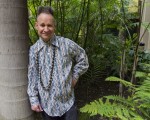Peter Sellars traveled halfway across the globe to see the dusty caverns of the Mogao Grottoes near Dunhuang, China.
“It was so overwhelming. The caves are so amazing in the history of arts, and yet a cool thing about them, they’re also amazing in the history of Buddhism,” Sellars said. “The cave paintings had musicians and dancers and wild, mind-blowing stories of beautiful beings that are coming to the walls, magically involved in these super psychedelic transformations.”
Sellars, a world arts and cultures professor and a theatrical director known for his interpretations of classical and contemporary operas and plays, developed an interest in the Buddhist-influenced art illustrated on the walls of the Mogao Grottoes 25 years ago, and has been collecting shelves of literature on the cave art and sculptures ever since. He began collaborating with the Getty Center two years ago to organize an exhibit on the caves that will be on display this summer.
Tim Whalen, director of the Getty Conservation Institute, said the Mogao Grottoes were created over a span of a thousand years between 400 and 1400 A.D., and only 500 fully painted ones remain today.
Whalen said the city of Dunhuang was a diverse, metropolitan center because of its location on the Silk Road. The influx of merchants, monks and nuns took refuge in the caves. Eventually, they transformed them into a spiritual center where families would commission artists to create Buddhist paintings and sculptures inside the caves.
Sellars decided to teach his summer session class, “Art as Moral Action,” on the topic of these art-filled Buddhist caves, so that the students would be able to visit the Getty Center’s upcoming exhibition of three life-sized replica caves. He also said the caves are a perfect subject for his class on morality because art and religion are part of humanity’s deepest convictions and can guide people to their inner perspective of ethics.
Sellars said his visit to the replicas was special because it was a totally immersive experience. He called them the first examples of installation art and virtual reality in history.
“I knew the images so well already, but it was shocking being right there in front of the original and seeing the spatialization of everything, of the paintings of people hurling themselves over the tops of the cavern, and surrounded by aquamarine,” Sellars said.
The Dunhuang Academy, which partnered up with the Getty Conservation Institute 25 years ago, was created in 1944 to research, replicate and preserve the cave art depicted on the walls. Whalen described them as the steward of the Mogao Grottoes. Working with the Getty, they are committed to the research and restoration of the caves.
Whalen said the replicas are created as a way to preserve the art on the cavern walls. Because the caves are full of visitors today, the humidity spike from the moisture in human breath causes the crystallization of salt, which pushes the paint off the surface of walls.
Professionals at the Dunhuang Academy and the Getty work to restore the original paintings, but they also create hand-painted replicas that are carefully modeled after how the caves currently look.
“Let’s say there’s a crack in the wall, or a piece of paint has fallen off the wall,” Whalen said. “(The restoration team) will paint that crack and paint that missing piece, exactly like what the caves look today.”
The hand-painted aspect preserves the original quality of the caves, said Sellars.
“(The caves) still have their ‘chi,’ the Chinese term for energy and life force, because it’s not a digital copy which would be brain dead, but it’s soulful and made with a lot of patience and skill,” Sellars said.
The caves are relevant to current events, Sellars said, in terms of how artistically they are similar to the recent pioneering of virtual reality, and socially how they are an example of the current trend of transnational migration.
“When you go into a cave, you are surrounded by images on your left, on your right, above you, behind you, and in front of you – you’re in a total world where the imagery is all moving to create a universal experience,” Sellars said.
Because Sellars bases his class, “Art as a Moral Action,” on the interconnectivity between art, religion and morality with modern issues, Harun Mehmedinovic, a UCLA alumnus, said the class was very applicable to the present day.
“When (Sellars) does a class, he roots it in what’s going on in the real world to bring awareness,” Mehmedinovic said. “He makes you think about what’s happening hundreds of miles away, thousands of miles away and what effect your actions have on society as a large.”

I doubt that Peter will see this but my intent is thankful – I am looking forward to seeing this show.